Maximilian II Emanuel, Elector of Bavaria
Last updatedThis article needs additional citations for verification .(May 2008) |
| Maximilian II Emanuel | |
|---|---|
 Portrait by Andreas Møller, c. 1726 | |
| Elector of Bavaria | |
| Reign | 26 May 1679 – 26 February 1726 |
| Predecessor | Ferdinand Maria |
| Successor | Charles Albert |
| 29th Governor of the Spanish Netherlands | |
| In office 1691 –7 March 1714 | |
| Monarchs | Charles II Philip V |
| Preceded by | Francisco Antonio de Agurto |
| Succeeded by | Prince Eugene of Savoy as governor of the Austrian Netherlands |
| Born | 11 July 1662 Munich,Electorate of Bavaria,Holy Roman Empire |
| Died | 26 February 1726 (aged 63) Munich,Electorate of Bavaria,Holy Roman Empire |
| Burial | |
| Spouses | |
| Issue Detail | |
| House | Wittelsbach |
| Father | Ferdinand Maria, Elector of Bavaria |
| Mother | Henriette Adelaide of Savoy |
| Religion | Roman Catholicism |
| Signature | |
Maximilian II (11 July 1662 – 26 February 1726), also known as Max Emanuel or Maximilian Emanuel, [1] was a Wittelsbach ruler of Bavaria and a Prince-elector of the Holy Roman Empire. He was also the last governor of the Spanish Netherlands and Duke of Luxembourg. An able soldier, his ambition led to conflicts that limited his ultimate dynastic achievements. [2]
Contents
- War against the Ottoman Empire
- Governor of the Spanish Netherlands
- War of the Spanish Succession
- Final years in Bavaria
- Cultural legacy
- Marriages and issue
- Ancestry
- References
- Sources
He was born in Munich to Ferdinand Maria, Elector of Bavaria and Princess Henriette Adelaide of Savoy (d.1676). His maternal grandparents were Victor Amadeus I of Savoy and Christine of France, daughter of King Henry IV of France.
War against the Ottoman Empire
Maximilian inherited the elector's mantle while still a minor in 1679 and remained under his uncle Maximilian Philipp's regency until 1680. By 1683 he was already embarked on a military career, fighting in the defence of Vienna against the attempt of the Ottoman Empire to extend their possessions further into Europe. He returned to court for long enough to marry Maria Antonia, daughter of Leopold I, Holy Roman Emperor and Margaret Theresa of Spain, on 15 July 1685 in Vienna, Austria. This marriage was very unhappy since the couple disliked each other, but it was successful in producing the desired heir for both Bavaria and the Spanish monarchy. Maximilian Emanuel's fame was assured when, in 1688, he led the capture of Belgrade from the Turks, with the full support of Serbian insurgents under the command of Jovan Monasterlija. [3] [4] [2]
Governor of the Spanish Netherlands
In the War of the Grand Alliance he again fought on the Habsburgs' side, protecting the Rhine frontier, and, being the Emperor's son-in-law and the husband of the King of Spain's niece, was appointed governor of the Spanish Netherlands in late 1691. [5]
His Netherlands adventure catalyzed Maximilian Emanuel's dynastic ambitions. One year after his appointment as governor, Maria Antonia died in Vienna, having given birth to a son, Joseph Ferdinand, who was appointed heir to the Spanish monarchy but died in 1699 before acceding the throne. An alternative avenue for Maximilian Emanuel's ambition was offered by his marriage on 12 January 1694 to Theresa Kunegunda Sobieska, the death of whose father, the elected King of Poland John III Sobieski, two years later, offered a potential avenue of influence in Polish affairs. [6] Maximilian II was a candidate in the 1697 Polish–Lithuanian royal election, however, in view of the lack of strong support from other powers, the limited royal authority by the Sejm of the Polish–Lithuanian Commonwealth, and his greater interest in assuming the Spanish throne, he did not make a serious effort for the Polish crown. [7]
However, he concentrated his interests in Western Europe, making his sons by Theresa Kunegunda Sobieska, Charles Albert and Clemens August, the principal beneficiaries of his ambitions.
The unsuccessful siege and bombardment of Brussels in 1695 during the Nine Years' War by French troops and the resulting fire during Max Emanuel's rule were together the most destructive event in the entire history of Brussels. [4] [2]
War of the Spanish Succession

Maximilian Emanuel, who had married Archduchess Maria Antonia, the sole child of Emperor Leopold's Spanish marriage, was one of the more serious claimants to the Spanish inheritance of Charles II of Spain, and the birth of his son Joseph Ferdinand in October 1692 immediately created a new claimant to the Spanish throne. In October 1698, William III of England and Louis XIV of France concluded the First Partition Treaty, which gave the Spanish crown with the Indies to Joseph Ferdinand, the Duchy of Milan to Emperor Leopold's younger son Archduke Charles, and the rest of Spanish Italy to France. The unexpected death of Joseph Ferdinand four months later voided this plan and in the Second Partition Treaty, the Bavarian portion of the inheritance was allotted to Archduke Charles. [8] By the outbreak of the War of the Spanish Succession in 1701, Maximilian Emanuel, who had long-term imperial aspirations, had hoped that his governorship of the Spanish Netherlands might yet reap the reward of a share of the Spanish inheritance from either Leopold or, failing him, Louis XIV. [9] Allying himself with the French against Austria, his campaign against Tyrol in 1703 did not have success and his plans were then frustrated by the disastrous defeat at the Battle of Blenheim in 1704.

In 1704–05, following the evacuation of the Bavarian court to the Spanish Netherlands after the defeat at the Battle of Blenheim, Max Emanuel's consort apparently was in charge of the government in the Stewardship of Munich of the Electorate of Bavaria as Regent Princess. However, when Theresa Kunegunda had found love letters of the Countess of Arco, a mistress of Max Emanuel, she left Munich to see her mother in Venice. The army would not allow her to return. In the ensuing evacuation of his court to the Netherlands, Maximilian Emanuel's family became separated and his sons were held prisoners for several years in Austria, Clemens August being brought up by Jesuits. Bavaria was partitioned between Austria and Johann Wilhelm, Elector Palatine. The harsh Austrian administration which managed to extract massive amounts of money and manpower from Bavaria led to a serious peasant uprising within a year. [10]
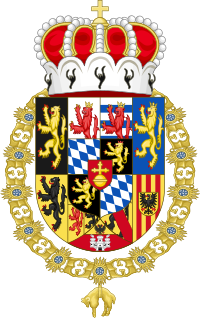
Maximilian Emanuel was again forced to flee the Netherlands after the Battle of Ramillies on 23 May 1706 and found refuge at the French court in Versailles where his late sister Maria Anna (1660–1690) had been the Dauphine of France . In 1712, Luxemburg and Namur were ceded to Maximilian Emanuel by his French allies, a cession that was not definitive since France was only the occupant of what was still the Spanish Netherlands. The war between France and Austria finally ended in 1714 in the Treaty of Rastatt in which Louis XIV compelled Austria to implement the full restoration of his faithful ally Maximilian Emanuel, including the return of the Upper Palatinate. Maximilian Emanuel was to remain in possession of Luxemburg, Namur and Charleroi until he was restored. [11] [4] [12] [2]
Final years in Bavaria
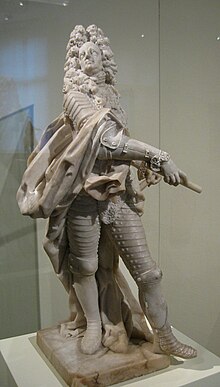
Back in Bavaria, Maximilian Emanuel focused on architecture projects to balance the failure of his political ambitions. It was bitter for him to witness the royal elevation of the German princes Augustus II the Strong (1697), Frederick I of Prussia (1701) and George I of Hanover (1714) as well as of his cousin Victor Amadeus of Sicily (1713) while his own political dreams could not be realized.
Maximilian Emanuel then supported the Habsburgs in a new war against the Turks, contributing troops to the Army of the Holy Roman Empire in (1717).
In 1724, he created a union of all lines of the Wittelsbach dynasty to increase the influence of his house. The Wittelsbach prince-electors Max Emanuel, his son Clemens August of Cologne, Charles III Philip, Elector Palatine and Franz Ludwig of Trier had at that time four votes at their disposal for the next imperial election. The crown of the Holy Roman Empire was sought for either Max Emanuel or his son Charles Albert. Already in 1722 Charles Albert had been married to the Habsburg Archduchess Maria Amalia of Austria.
In 1726, Max Emanuel died of a stroke. He is buried in the crypt of the Theatinerkirche in Munich. [2]
Cultural legacy


During his entire reign Maximilian II Emanuel patronized the arts. As governor of the Spanish Netherlands he acquired numerous Dutch and Flemish paintings for the Wittelsbach collection.
The first half of Max Emanuel's reign was still dominated by his parents' Italian court artists, like Enrico Zuccalli and Giovanni Antonio Viscardi. Between 1684 and 1688, Zuccalli built the Italian style Lustheim Palace for Max Emanuel and his first wife Maria Antonia, located on a central island. With the appointment of Joseph Effner serving as chief architect of the court and the young François de Cuvilliés as his assistant, the French influence significantly increased and Max Emanuel's return in 1715 marked the origin of the era of Bavarian Rococo. [13] [14]
The Nymphenburg Palace was enlarged, the Dachau Palace redesigned, and the new Schleissheim Palace was finally completed (1726) during Max Emanuel's reign. These palaces were connected with a network of canals as Max Emanuel had become acquainted with in the Netherlands. Between 1715 and 1717, he had the Baroque style Fürstenried Palace built by Effner as a hunting lodge which was the extension and modification of an already existing noble mansion. [15] [16]
Marriages and issue

First marriage with Maria Antonia of Austria, daughter of Emperor Leopold I, Holy Roman Emperor:
- Leopold Ferdinand (b. and d. 1689)
- Anton (b. and d. 1690)
- Joseph Ferdinand (1692–1699)
Second marriage with Theresa Kunegunda Sobieska of Poland, daughter of King John III Sobieski:
- Stillborn child (1695)
- Maria Anna Karoline (1696–1750), since 1720 a nun
- Charles Albert (1697–1745), elector of Bavaria, King of Bohemia and Holy Roman Emperor, ∞ 1722 Maria Amalia Josepha Anna of Austria (1701–1756)
- Philipp Moritz Maria (1698–1719), elected bishop of Paderborn and Münster
- Ferdinand Maria (1699–1738), imperial general
- Clemens August (1700–1761), Grand Master of the Teutonic Order, Prince Archbishop of Cologne, Bishop of Regensburg, Paderborn, Osnabrück, Hildesheim and Münster
- Wilhelm (1701–1704)
- Alois Johann Adolf (1702–1705)
- Johann Theodor (1703–1763), Cardinal, Prince bishop of Regensburg, Freising and Liege
- Maximilian Emanuel Thomas (1704–1709)
He had an illegitimate child with his French mistress Agnes Françoise Louchier;
- Emmanuel François Joseph, Count of Bavaria (1695–1747) had two children with Maria Josepha Karolina von Hohenfels; also had an affair with Louise Anne de Bourbon, grand daughter of Madame de Montespan.
Ancestry
| Ancestors of Maximilian II Emanuel, Elector of Bavaria | ||||||||||||||||||||||||||||||||||||||||||||||||||||||||||||||||||||||||||||||||||||||||||||||||||||||||||||||||||||||||||||||||||||||||||||||||||||||||||||||||||||||||||||||||||||||||||||||||||||||||||||||||||||||||||||||||||||||||||||||||||||||||||||||||||||||||||||||||||||||||||||||||||||||||||||||||||||||||||||||||||||||||||||||||||||||||||||||||||||||||||||||||||||||||||||||||||||||||||||||||||||||||||||||||||||||||||||||||||||||||||||||||||||||||||||||||||||||||||||||||||||||||||||||||||||||||||||||||||||||||||||||||||||||||||||||||||||||||||||||||||||||||||||||||||||||||||||||||
|---|---|---|---|---|---|---|---|---|---|---|---|---|---|---|---|---|---|---|---|---|---|---|---|---|---|---|---|---|---|---|---|---|---|---|---|---|---|---|---|---|---|---|---|---|---|---|---|---|---|---|---|---|---|---|---|---|---|---|---|---|---|---|---|---|---|---|---|---|---|---|---|---|---|---|---|---|---|---|---|---|---|---|---|---|---|---|---|---|---|---|---|---|---|---|---|---|---|---|---|---|---|---|---|---|---|---|---|---|---|---|---|---|---|---|---|---|---|---|---|---|---|---|---|---|---|---|---|---|---|---|---|---|---|---|---|---|---|---|---|---|---|---|---|---|---|---|---|---|---|---|---|---|---|---|---|---|---|---|---|---|---|---|---|---|---|---|---|---|---|---|---|---|---|---|---|---|---|---|---|---|---|---|---|---|---|---|---|---|---|---|---|---|---|---|---|---|---|---|---|---|---|---|---|---|---|---|---|---|---|---|---|---|---|---|---|---|---|---|---|---|---|---|---|---|---|---|---|---|---|---|---|---|---|---|---|---|---|---|---|---|---|---|---|---|---|---|---|---|---|---|---|---|---|---|---|---|---|---|---|---|---|---|---|---|---|---|---|---|---|---|---|---|---|---|---|---|---|---|---|---|---|---|---|---|---|---|---|---|---|---|---|---|---|---|---|---|---|---|---|---|---|---|---|---|---|---|---|---|---|---|---|---|---|---|---|---|---|---|---|---|---|---|---|---|---|---|---|---|---|---|---|---|---|---|---|---|---|---|---|---|---|---|---|---|---|---|---|---|---|---|---|---|---|---|---|---|---|---|---|---|---|---|---|---|---|---|---|---|---|---|---|---|---|---|---|---|---|---|---|---|---|---|---|---|---|---|---|---|---|---|---|---|---|---|---|---|---|---|---|---|---|---|---|---|---|---|---|---|---|---|---|---|---|---|---|---|---|---|---|---|---|---|---|---|---|---|---|---|---|---|---|---|---|---|---|---|---|---|---|---|---|---|---|---|---|---|---|---|---|---|---|---|---|---|---|---|---|---|---|---|---|---|---|---|---|---|---|---|---|---|---|---|---|---|---|---|---|---|---|---|---|---|---|---|---|---|---|---|---|---|---|---|---|---|---|---|---|---|---|---|---|---|---|---|---|---|---|---|---|---|---|---|---|---|---|---|---|---|---|---|---|---|---|---|---|---|---|---|---|---|---|---|---|---|---|---|---|---|---|---|---|---|---|---|---|---|---|---|---|---|---|---|---|---|---|---|---|---|---|---|---|---|---|---|---|---|---|---|---|---|---|---|---|---|---|---|---|---|---|---|---|---|---|---|---|---|---|---|---|---|---|---|
| ||||||||||||||||||||||||||||||||||||||||||||||||||||||||||||||||||||||||||||||||||||||||||||||||||||||||||||||||||||||||||||||||||||||||||||||||||||||||||||||||||||||||||||||||||||||||||||||||||||||||||||||||||||||||||||||||||||||||||||||||||||||||||||||||||||||||||||||||||||||||||||||||||||||||||||||||||||||||||||||||||||||||||||||||||||||||||||||||||||||||||||||||||||||||||||||||||||||||||||||||||||||||||||||||||||||||||||||||||||||||||||||||||||||||||||||||||||||||||||||||||||||||||||||||||||||||||||||||||||||||||||||||||||||||||||||||||||||||||||||||||||||||||||||||||||||||||||||||
Related Research Articles

The House of Wittelsbach is a former Bavarian dynasty, with branches that have ruled over territories including the Electorate of Bavaria, the Electoral Palatinate, the Electorate of Cologne, Holland, Zeeland, Sweden, Denmark, Norway, Hungary, Bohemia, and Greece. Their ancestral lands of Bavaria and the Palatinate were prince-electorates, and the family had three of its members elected emperors and kings of the Holy Roman Empire. They ruled over the Kingdom of Bavaria which was created in 1805 and continued to exist until 1918.
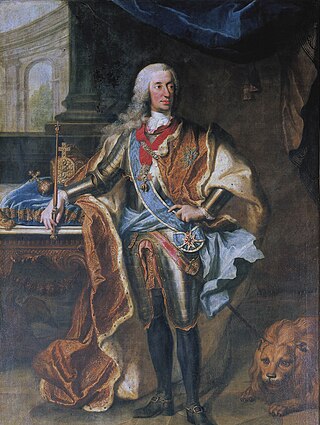
Charles VII was Prince-Elector of Bavaria from 26 February 1726 and Holy Roman Emperor from 24 January 1742 to his death. He was also King of Bohemia from 1741 to 1743. Charles was a member of the House of Wittelsbach, and his reign as Holy Roman Emperor thus marked the end of three centuries of uninterrupted Habsburg imperial rule, although he was related to the Habsburgs by both blood and marriage.

Clemens August of Bavaria was an 18th-century member of the Wittelsbach dynasty of Bavaria and Archbishop-Elector of Cologne.

Joseph Ferdinand Leopold of Bavaria was the son of Maximilian II Emanuel, Elector of Bavaria and his first wife, Maria Antonia of Austria, daughter of Leopold I, Holy Roman Emperor, maternal granddaughter of King Philip IV of Spain.

Maximilian I, occasionally called the Great, a member of the House of Wittelsbach, ruled as Duke of Bavaria from 1597. His reign was marked by the Thirty Years' War during which he obtained the title of a Prince-elector of the Holy Roman Empire at the 1623 Diet of Regensburg.

Ferdinand Maria was a Wittelsbach ruler of Bavaria and a prince-elector of the Holy Roman Empire from 1651 to 1679. The Elector modernized the army and introduced Bavaria's first government code. Besides encouraging agriculture and industry, he also improved building and restoration works on churches and monasteries since the damage caused during the Thirty Years' War.

The Nymphenburg Palace is a Baroque palace situated in Munich's western district Neuhausen-Nymphenburg, in Bavaria, southern Germany. The Nymphenburg served as the main summer residence for the former rulers of Bavaria of the House of Wittelsbach. Combined with the adjacent Nymphenburg Palace Park it constitutes one of the premier royal palaces of Europe. Its frontal width of 632 m (2,073 ft) even surpasses Versailles.

Theresa Kunegunda, was a Polish princess, Electress of Bavaria and of the Electorate of the Palatinate. By birth she was member of the House of Sobieski and by marriage member of the House of Wittelsbach. She also served as Regent of the Palatinate in 1704–05.

Maximilian III Joseph, "the much beloved", was a Prince-elector of the Holy Roman Empire and Duke of Bavaria from 1745 to 1777. He was the last of the Bavarian branch of the House of Wittelsbach and because of his death, the War of Bavarian Succession broke out.

Archduke Ferdinand Karl of Austria-Este was a son of Holy Roman Emperor Franz I and Maria Theresa of Austria. He was the founder of the House of Austria-Este and Governor of the Duchy of Milan between 1765 and 1796. He was also designated as the heir to the Duchy of Modena and Reggio, but he never reigned, owing to the Napoleonic Wars.
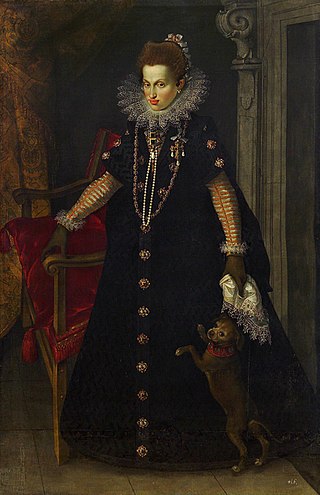
Maria Anna of Bavaria was a German princess, a member of the House of Wittelsbach by birth and an Archduchess consort of Inner Austria by marriage.
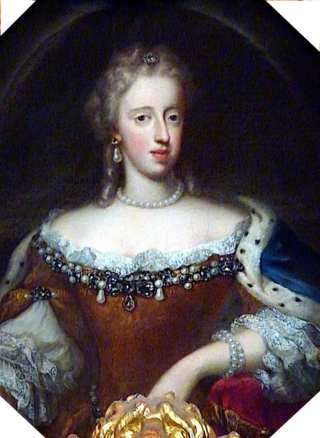
Maria Antonia Josepha Benedicta Rosalia Petronella of Austria was an Electress of Bavaria as the wife of Maximilian II Emanuel, Elector of Bavaria. She was the eldest daughter and only surviving child of Leopold I, Holy Roman Emperor and his first wife Margaret Theresa of Spain. She was the heiress to the Spanish throne after her maternal uncle Charles II of Spain from 1673 until her death.

Henriette Adelaide of Savoy, was Electress of Bavaria by marriage to Ferdinand Maria, Elector of Bavaria. She had much political influence in her adopted country and with her husband did much to improve the welfare of the Electorate of Bavaria.

The Electorate of Bavaria was a quasi-independent hereditary electorate of the Holy Roman Empire from 1623 to 1806, when it was succeeded by the Kingdom of Bavaria.

Maria Josepha of Bavaria was Holy Roman Empress, Queen of the Romans, Archduchess of Austria, and Grand Duchess of Tuscany, among other titles, by her marriage to Joseph II, Holy Roman Emperor. By birth, she was a Princess and Duchess of Bavaria as the daughter of Charles VII, Holy Roman Emperor, elector of Bavaria, and Archduchess Maria Amalia of Austria.

The House of Sobieski was a prominent magnate family of Polish nobility in the 16th and 17th centuries, from which the King of Poland and Grand Duke of Lithuania Jan III Sobieski originated. The family used the Janina coat of arms.

Archduchess Auguste Ferdinande of Austria was the only daughter of Leopold II, Grand Duke of Tuscany and his first wife, Maria Anna of Saxony to survive to adulthood. She married Prince Luitpold of Bavaria, who later became the Prince Regent of Bavaria after her death.

Theresa Benedicta of Bavaria was a Princess of Bavaria.
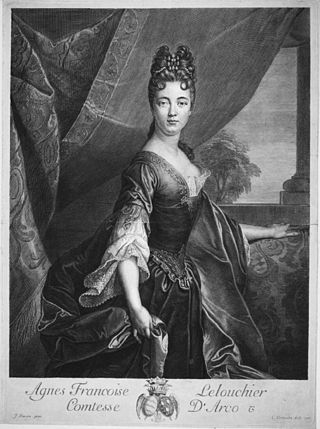
Agnes-Françoise Le Louchier (1660-1717), was the royal mistress of Maximilian II Emanuel, Elector of Bavaria from 1694 until 1717. She also served as the spy of Bavaria at the French court.

The imperial election of 1742 was an imperial election held to select the emperor of the Holy Roman Empire. It took place in Frankfurt on January 24. The result was the election of Charles Albert of Bavaria, the first non-Habsburg emperor in three hundred years.
References
- ↑ Spencer 2005.
- 1 2 3 4 5 Evelyne Bechmann (17 September 2014). Die Frauen der Wittelsbacher: Ein Frauenbild vom Mittelalter bis in die Gegenwart. BoD – Books on Demand. pp. 38–. ISBN 978-3-7357-8187-1.
- ↑ Peter Wilson (1 November 2002). German Armies: War and German Society, 1648–1806. Routledge. pp. 68–. ISBN 978-1-135-37053-4.
- 1 2 3 Derek Mckay; H.M. Scott (19 September 2014). The Rise of the Great Powers 1648 - 1815, p.74 -. Routledge. ISBN 978-1-317-87284-9.
- ↑ Storrs 1999, p. 8.
- ↑ Claudia von Kruedener (23 March 2020). Kurfürstin Therese Kunigunde von Bayern (1676–1730): und ihre Friedenspolitik in europäischen Dimensionen Zwischen Papst und Kaiser. Verlag Friedrich Pustet. pp. 61–. ISBN 978-3-7917-7281-3.
- ↑ Orszulik, Stanisław (1974). "Kandydatura elektora bawarskiego Maksymiliana II Emanuela do korony polskiej po śmierci Jana III". Śląski Kwartalnik Historyczny Sobótka (in Polish). XXIX (2). Wrocław: Zakład Narodowy im. Ossolińskich, Wydawnictwo Polskiej Akademii Nauk: 233–234.
- ↑ Joachim Whaley, Germany and the Holy Roman Empire, volume II, Oxford University Press, 2012, p. 108–109.
- ↑ Joachim Whaley, p. 115.
- ↑ Joachim Whaley, p. 115
- ↑ Joachim Whaley, p. 117–118.
- ↑ Reginald de Schryver (1996). Max II. Emanuel von Bayern und das spanische Erbe. P. von Zabern. ISBN 978-3-8053-1621-7.
- ↑ "François de Cuvilliés". Getty. Archived from the original on March 12, 2007. Retrieved April 13, 2020.
- ↑ Michael Robertson (2009). The Courtly Consort Suite in German-speaking Europe, 1650–1706. Ashgate Publishing, Ltd. pp. 175–. ISBN 978-0-7546-6451-2.
- ↑ "Schloss und Schlossgarten Nymphenburg – Die Gartengebäude von Kurfürst Max II. Emanuel – Die Pagodenburg" (PDF). Süddeutscher Barock ch. October 7, 2017. Retrieved April 13, 2020.